We grow gladioli on the windowsill in flower pots
Gladioli, or popularly known as swords, are very beautiful and solemn flowers that can decorate any area and make a flower garden or flower bed more spectacular. Many people still consider these cultures to be street cultures, but this is a big misconception.From this article you will learn in detail how to grow and care for gladioli in ordinary flower pots in the house on the windowsill.
|
Gladioli in pots look like a huge bouquet. You can easily grow such an unusual and exquisite bouquet at home. |
Is it possible to grow gladioli in pots in the house, on the balcony or outside?
Of course, it is difficult to imagine a huge flower about one and a half meters high in a flower container in a closed space. This is also impossible because the root system of flowering plants simply does not fit in the pot, and full growth and flowering can hardly be expected. But for all lovers of gladioli, as a result of breeding work, new varieties and varieties have been obtained that feel great in flowerpots, large and medium-sized planting containers.
Gladioli can be grown at home: on a balcony and loggia, on a closed terrace and in an apartment, in a private house and on the veranda. Miniature plants have a small height for the room - from twenty-five to sixty centimeters, which greatly simplifies their care. The size of their flowers is slightly smaller than usual, but the palette of colors is more varied and rich. By growing several gladioli bulbs in one pot, you can get a lush holiday bouquet.
In this video you can watch the entire process of growing potted gladioli from planting the bulbs to flowering:
What varieties of gladioli can be grown in pots?
Low-growing varieties of gladioli are compact and do not need support. Their unpretentiousness allows you to stay indoors in the cold months, and outdoors in the warm months. Such changes in growing conditions do not affect the full development of plants and the quality of flowering. Among the variety of varieties and hybrids, several of the most popular and suitable for planting in flowerpots and pots can be identified.
Moscow white stone
|
Moscow white stone is a snow-white, spectacular, highly corrugated hybrid with lush flowering, obtained by domestic breeders. |
The flower is not afraid of rain and cold. An important feature of the variety is its large daughter bulbs, the average diameter of which is about four centimeters.
- The height of the bush is about sixty centimeters.
- When flowering, from thirty to forty white almost double flowers with a cream neck bloom simultaneously on the plants.
- Mid-early fast-growing variety. Need a garter.
Tinkerbell (Tinkerbell)
|
Tinkerbell (Tinkerbell) – a variety with a butterfly-shaped flower, ideal for pot cultivation at home |
- The height of an adult plant is from forty to seventy centimeters.
- The spike-shaped inflorescences consist of many bright orange flowers with a yellow throat with a diameter of six to ten centimeters.
- Prefers to grow in a light nutrient substrate (with drainage) in a warm and well-lit place, without drafts.
- No support required.
Charm
|
Charm is a mini variety with spectacular corrugated petals of raspberry-pink color. Agrotechnics of cultivation and care are usual.The flowering period lasts from July to September. |
- The stem is straight and thin, the leaves are narrow and pointed.
- Luxurious spike-shaped inflorescences consist of many neat flowers with a diameter of about seven centimeters.
- Plant height is from forty to sixty centimeters.
- It is highly resistant to various diseases.
Atom
|
Atom is a low-growing variety that is highly resistant to diseases and pests. |
- The average height of the plant is 50 - 60 centimeters, but in favorable conditions it can reach seventy centimeters.
- The flowering period is long.
- The peduncles are straight, the flowers are bright red with a white border. Flower size is 7-8 cm.
- Doesn't need support. Ideal for pot growing.
Robinetta
|
Robinetta is an early flowering hybrid variety for container growing and cutting. Blooms throughout the summer. |
- The average height of a flowering bush is forty-five to fifty centimeters. The leaf blades are xiphoid and bright green.
- Fragrant flowers with red-pink petals with a diameter of five to seven centimeters are collected in spike-shaped inflorescences. The length of the ear is about twenty-five centimeters, each has about fifteen buds.
- It is highly resistant to drought and is not afraid of direct sunlight.
Prince Claus
|
Prince Claus is a universal miniature variety for planting in open and closed ground. They show their best qualities in places with the maximum amount of sun. |
- The height of the stem is from forty to fifty centimeters.On each of them, about ten asymmetrical flowers with diameters of six to nine centimeters (in full opening) are formed.
- The flowering period lasts three to four months. Gently pink buds, after opening, turn into beautiful white flowers with a spot - a drop of cherry shade in the center of the petal.
- Plants do not need staking.
What pots and soil are needed?
Choosing pots
When choosing a container or pot for planting home gladioli, you must follow some rules.
- Containers can be made of clay, plastic, ceramics or any other material.
- The size, and especially the depth, of the pot is of great importance. The most suitable volume is from seven to ten liters, no less. The diameter of the container is from thirty centimeters, and the depth is from forty centimeters. Flower crops grow best in deep containers.
- Drainage holes at the bottom of the pot are required.
- To drain excess water, you should immediately purchase a tray for each pot.
|
It is better to choose deep and spacious pots for planting gladioli. |
What kind of soil is needed?
When choosing a ready-made substrate in specialized stores, you need to choose a soil mixture for indoor flower crops. If the soil mixture is prepared at home, then a prerequisite before use is its disinfection. To do this, the soil is spilled with boiling water and a weak solution of potassium permanganate before planting.
Soil requirements: lightness, looseness, good permeability, fertility, presence of all nutrients necessary for indoor plants. Loamy soil is mixed in equal parts with coarse river sand. Ideally, moisture-absorbing loose soil contains a large amount of humus.
Important! The nutrient substrate is poured into the flower container only after a generous drainage layer.
When and how to plant bulbs in pots
Landing dates
The favorable period for planting potted gladioli is from the beginning of April to the end of May. It is important to calculate this date so that the flowering period begins and ends with the longest possible daylight hours. Gladioli need plenty of sunlight to grow fully.
Don't forget to read:
Planting gladioli bulbs in open ground, features of cultivation and care ⇒
Selection and preparation of planting material
To obtain powerful peduncles with a large number of flowers, it is recommended to choose only healthy and strong bulbs with a diameter of three to five centimeters for planting. All planting material must be carefully inspected. Bulbs with suspicious spots, cracks, or scratches should not be used. There is also no need to plant overdried, weak and rotten specimens.
On a note! With a limited number of healthy bulbs, you can try to revive tubers with minor damage. They are carefully cut using a sharp sterile knife, after which the cut areas are sprinkled with wood ash or activated carbon powder.
Fifteen to twenty days before planting, preparatory activities begin. First, all planting material is carefully cleaned of dry scales, then they are disinfected and preventively treated against diseases and pests.
Treatment options:
- soaking the bulbs in a solution of potassium permanganate (for thirty minutes) or copper oxychloride (for two to three hours);
- soaking in a solution of Bordeaux mixture (three to four hours);
- pest control treatment for half an hour with ready-made preparations “Dichlorvos”, “Karbofos”, “Aktara”, “Aktellik”, “Fufanon”;
- treatment to prevent diseases - “Fundazol”, “Maxim” (according to instructions);
- for feeding and stimulating root formation - “Zircon”, “Epin”, “Kornevin”.
After processing, all material is dried a little, then placed in cardboard boxes or paper bags and left in a cool room until planting. Only bulbs with emerging shoots should be planted.
This video shows in detail the process of planting bulbs in pots:
Choosing a favorable place for flowers
When caring for gladioli, you need to take into account that they love light and warmth, so you need to choose a place for growing that is warm, bright and without drafts. In spring, a south-facing window sill, glazed balcony or loggia is suitable for this. In the daytime, when warm weather sets in with temperatures above fifteen degrees Celsius, potted crops can be taken out into the open air for several hours, and in summer containers with flowers can be left outside for a long time. During the flowering period, it is worth protecting gladioli from prolonged exposure to direct sunlight. It is better to choose a place in light partial shade.
For the comfort of flowering plants, it is recommended to periodically humidify the air in the room using a spray bottle or place a wide container (tray) with water next to them. The optimal temperature in a room with gladioli is twenty degrees Celsius.
Do not miss:
Read about how to properly prepare gladioli bulbs for planting in the ground in the spring here ⇒
Boarding procedure
|
Step-by-step planting of gladioli bulbs in pots |
Pots and other planting containers are filled with drainage material (for example, expanded clay), then the prepared nutrient substrate is poured and moistened. The tuber is buried eight to ten centimeters, sprinkled with soil and compacted a little. When planting several bulbs in one pot or long container, the optimal distance between them is at least six centimeters.
Caring for gladioli in pots
Lighting requirements
To grow gladioli indoors, it is important to install additional lighting that compensates for the lack of sunlight during periods with short daylight hours. In the morning and evening hours in spring and autumn, fluorescent lamps will help crops remain in comfortable conditions and continue to fully develop.
Irrigation regime
Watering fennel in pots is carried out more often than in an open flower garden or flower bed. To determine the optimal volume of water and frequency of watering, it is recommended to take into account several factors - the volume of the container, the size of the plant, weather conditions (if the potted plant is located in an outdoor area) or the level of humidity in the room. On hot summer days, the frequency of watering is approximately three to four times a week.
|
If the soil is covered with mulching material (for example, humus or peat), then its moisture resistance increases significantly and the number of waterings is reduced. |
Attention! Irrigation water should be settled, soft or purified, the water temperature should be about twenty to twenty-two degrees.
Fertilizer application
For lush and long flowering, as well as for active growth, plants need regular and proper feeding (root and foliar).
- Fertilizers with nitrogen and potassium are applied when the second or third true leaf appears.
- After the formation of the fifth and sixth leaves, it is recommended to add a small amount of boric acid to the nitrogen-potassium fertilizer (ten grams of each).
- The following fertilizers are a mineral complex for indoor plants (according to the instructions).
- After flowering, gladioli require potassium and phosphorus.
|
Organic and mineral fertilizers should be alternated, the optimal interval is two weeks. |
Soil care
To maintain lightness and good permeability, the soil must be loosened periodically and not allowed to become compacted after watering. A small layer of peat on the soil surface will help retain moisture even longer and provide a constant flow of air to the root part of the flower.
Garter
Most varieties for pot and container cultivation do not need gartering or support, since their average height does not exceed sixty to seventy centimeters. The exception is those gladioli on which a large number of buds are formed and the stems become heavy.
|
To prevent the garter from damaging the surface of the stem, it is better to use a soft rope or strip of fabric. |
Trimming
It is recommended to trim the above-ground part of the flower after flowering, when it withers naturally. It is necessary to leave stumps no more than five to seven centimeters high above the soil surface.
Disease and pest control
Possible pests are aphids, thrips, slugs, spider mites. To combat them, use tobacco dust, dry mustard powder or table salt. The substance is scattered on the surface of the soil around the bush (meaning salt) or the entire plant is powdered.At an early stage, folk remedies help - spraying with soap solution, onion or ash infusion. To combat a large number of pests, special chemicals will be required - “Aktara”, “Aktellik”, “Intavir”, “Dichlorvos”.
At home, gladioli rarely get sick. The cause of any disease can be improper care, namely improper watering, lack of nutrients, or untimely care of the soil. To prevent and combat illnesses, Fundazol or other suitable drugs are used.
What other plants can be planted in pots with gladioli?
Various varieties of annuals or perennials can be planted in pots with gladioli. For example, in a pot with dwarf varieties of fennel, you can plant lobelia, bacopa, lobularia or ageratum. Oregano, barberry, sage and spirea will get along well with fennel. Bindweed, marigolds, and snapdragons will be good annual companions.
|
Potted gladioli in combination with other plants |
Caring for potted gladioli after flowering
After flowering has ended and the wilted above-ground part has been trimmed, the pot is transferred to a cool room, in complete darkness. The plant remains in these conditions until mid-autumn. In the fall, the bulbs are removed from the soil, dried a little, then the children are separated from the rhizome and sent for storage in a cool place with a temperature of three to six degrees Celsius.
What to do with flowers in winter
In winter, the bulbs are stored in a cardboard box or other container in sawdust or wood ash, sand or newsprint.To store planting material, choose any suitable place: the bottom shelf of the refrigerator, a glazed balcony or loggia, a cellar or basement, an attic or a storage room.
Don't forget to read:
Read how to properly prepare and store gladioli bulbs in winter here ⇒
What problems may arise
When growing gladioli in pots or flowerpots, one of the most common problems is drying out of the soil or the appearance of mold. This happens when the wrong irrigation regime is selected. Insufficient watering leads to dryness of the substrate, and excessive watering leads to waterlogging. Both of these factors negatively affect plant roots, their oxygen saturation and the development of the crop as a whole. Both problems can be solved by using a mulch layer, which will maintain moderate moisture in the soil and prevent compaction. With proper care for gladioli, no problems should arise.
Do not miss:
Conclusion
Gladioli in pots are an excellent decor for home and garden, decoration for loggias and balconies. Growing this universal flower is accessible to everyone, with or without experience. The main thing is to arm yourself with the necessary knowledge and you can safely start landscaping your space.
You might be interested:
|
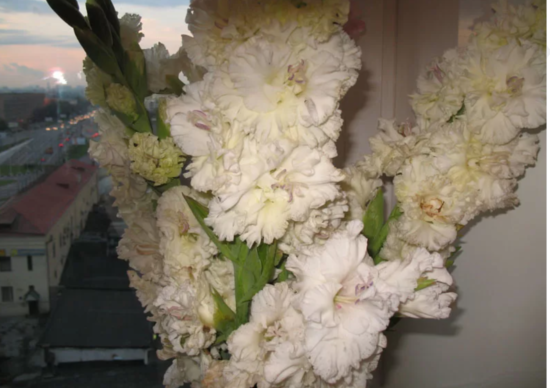
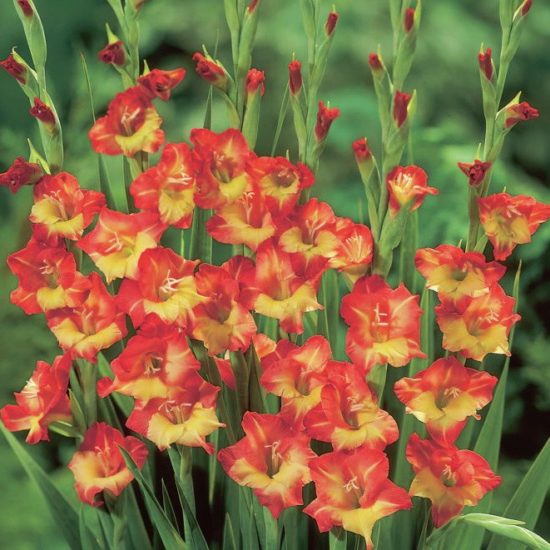
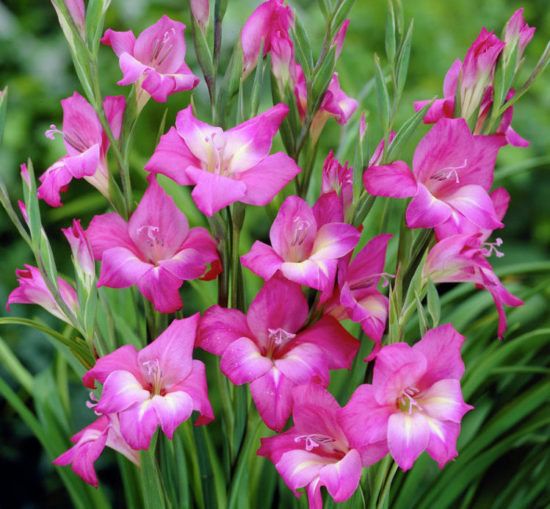
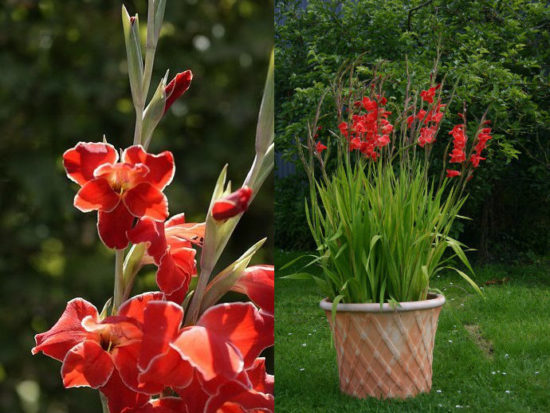
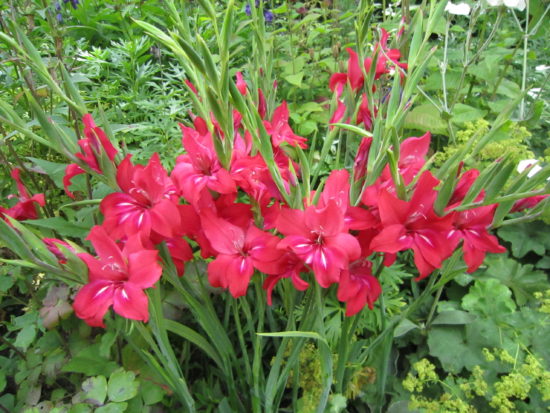
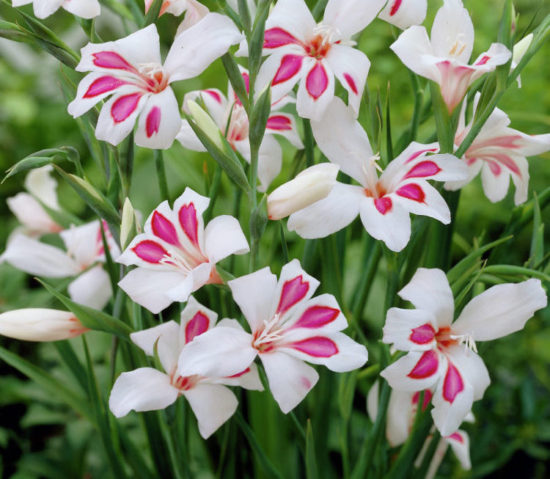
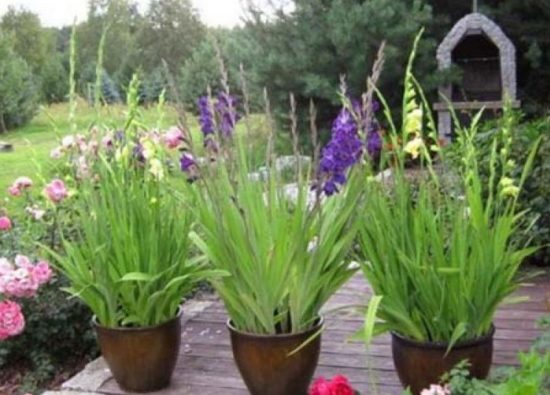
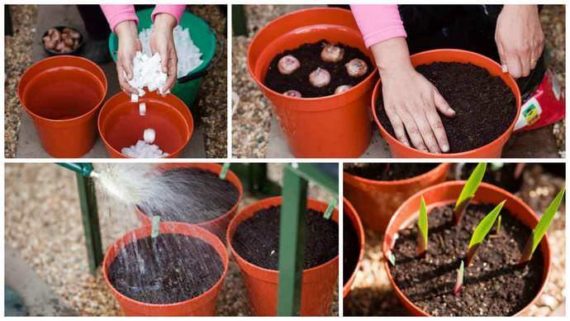
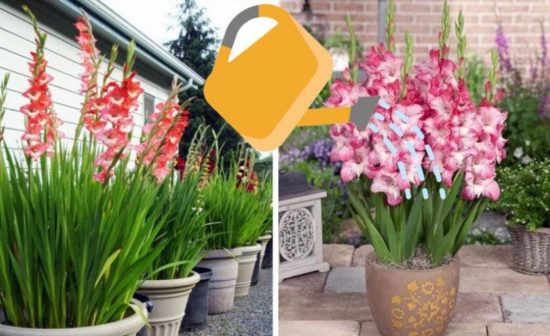
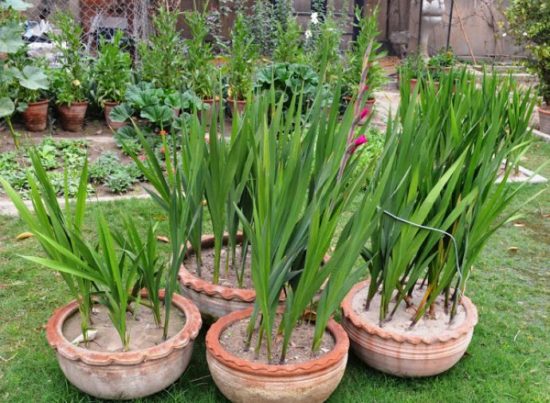
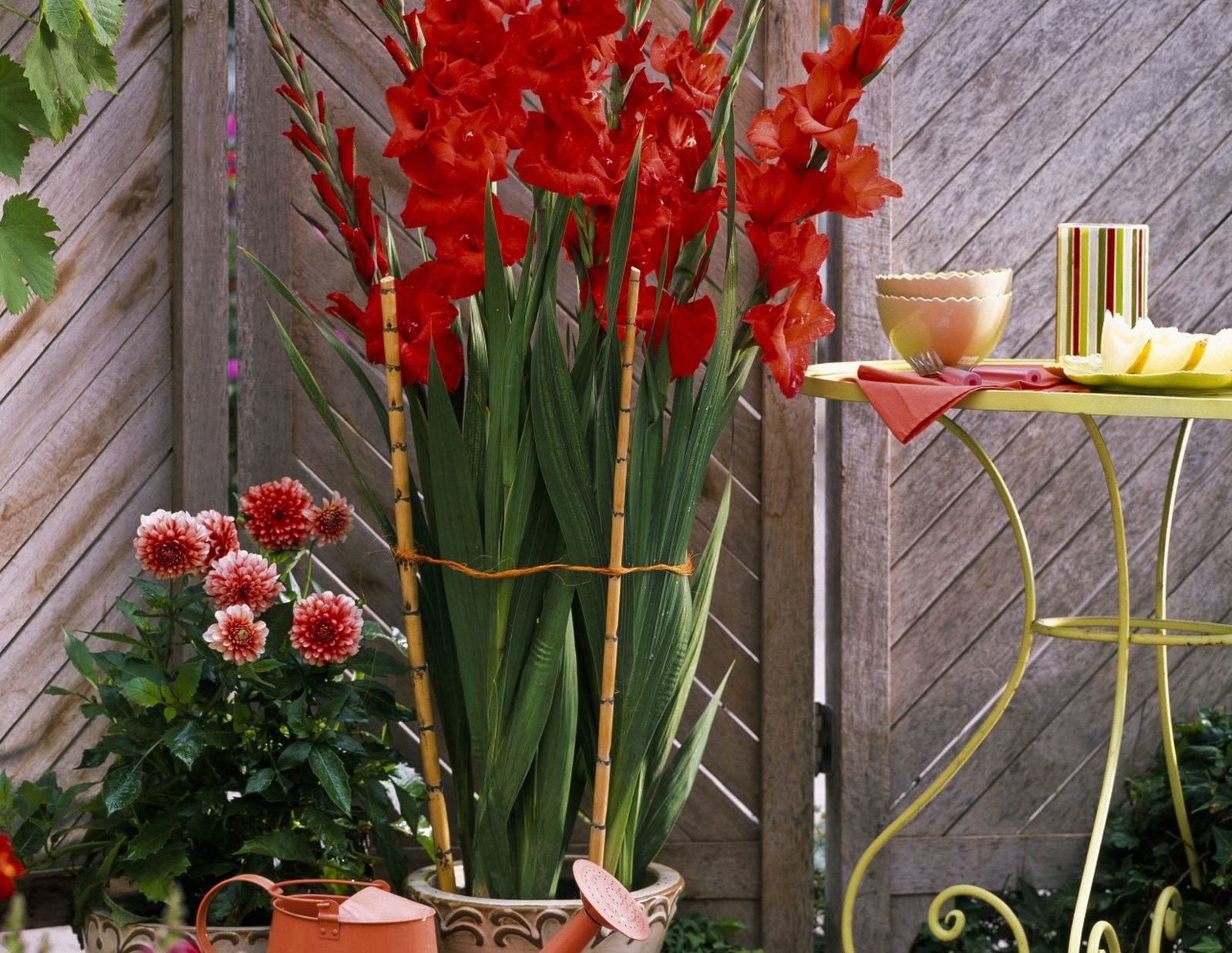
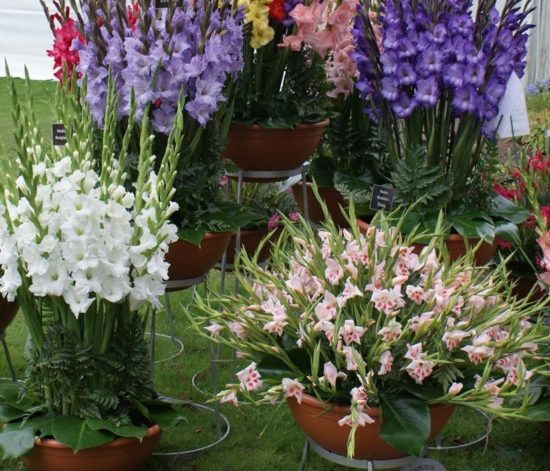

 CUCUMBERS NEVER GET SICK, I'VE BEEN USING ONLY THIS FOR 40 YEARS! I SHARE A SECRET WITH YOU, CUCUMBERS ARE LIKE THE PICTURE!
CUCUMBERS NEVER GET SICK, I'VE BEEN USING ONLY THIS FOR 40 YEARS! I SHARE A SECRET WITH YOU, CUCUMBERS ARE LIKE THE PICTURE! You can dig a bucket of potatoes from each bush. Do you think these are fairy tales? Watch the video
You can dig a bucket of potatoes from each bush. Do you think these are fairy tales? Watch the video
 How our fellow gardeners work in Korea. There is a lot to learn and just fun to watch.
How our fellow gardeners work in Korea. There is a lot to learn and just fun to watch. Eye trainer. The author claims that with daily viewing, vision is restored. They don't charge money for views.
Eye trainer. The author claims that with daily viewing, vision is restored. They don't charge money for views. A 3-ingredient cake recipe in 30 minutes is better than Napoleon. Simple and very tasty.
A 3-ingredient cake recipe in 30 minutes is better than Napoleon. Simple and very tasty. Therapeutic exercises for cervical osteochondrosis. A complete set of exercises.
Therapeutic exercises for cervical osteochondrosis. A complete set of exercises. Which indoor plants match your zodiac sign?
Which indoor plants match your zodiac sign? What about them? Excursion to German dachas.
What about them? Excursion to German dachas.